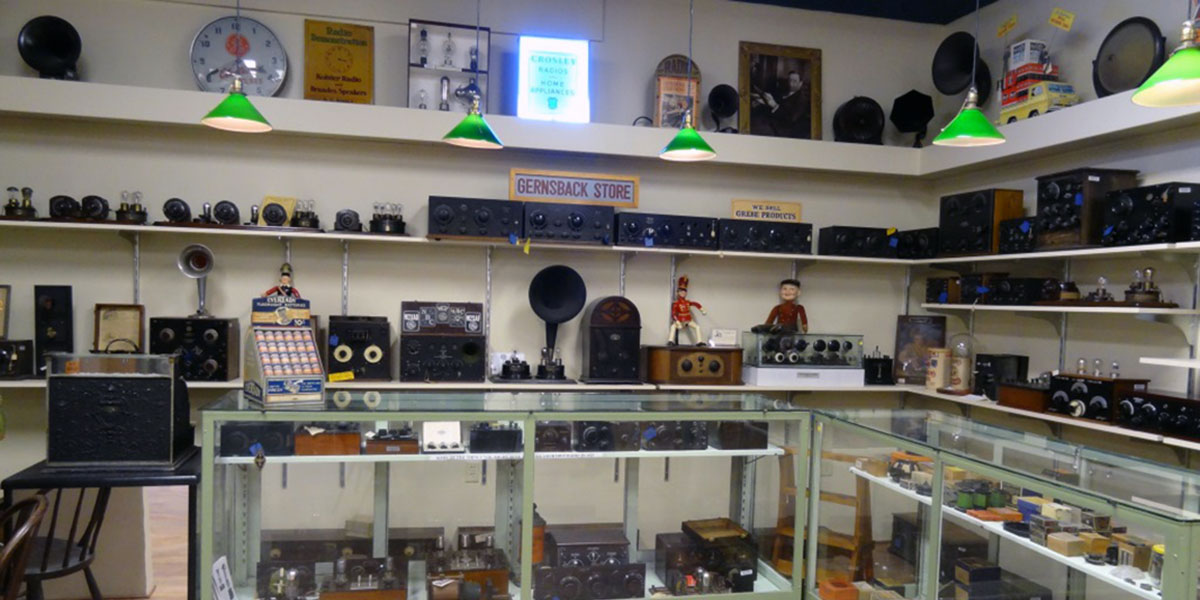For anyone interested in electronics, its history, and development, a trip to the Antique Wireless Association Museum is a must.
The museum is located in the small and picturesque town of Bloomfield, NY and features some of the most unusual and rare exhibits of wireless, telegraph, radio, and television ever assembled. The museum is one of the few devoted to research, preservation, and documentation of the history of wireless communications.
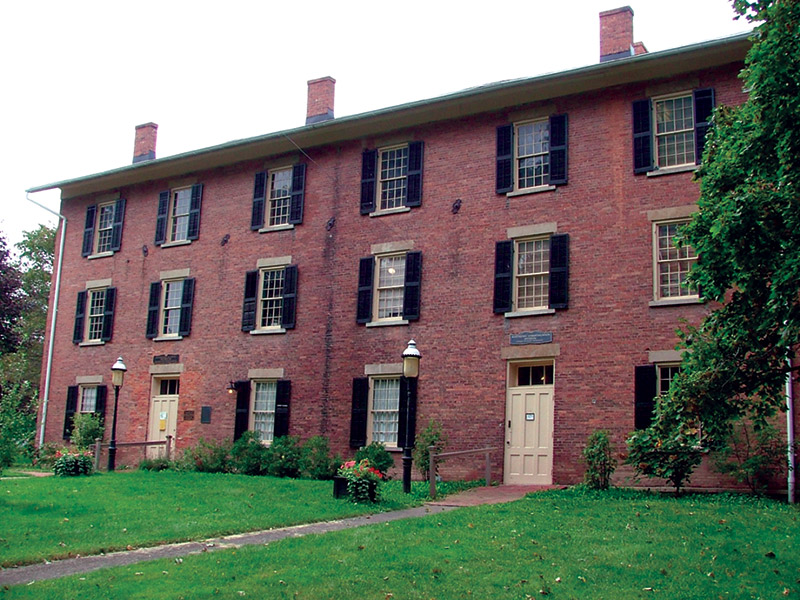
The Antique Wireless Museum in Bloomfield, NY is housed in a former school and celebrated landmark of the Finger Lakes region of New York, built in 1837.
Even the building housing the museum has a unique history. It’s a former school built in 1837 and is a celebrated landmark of the Finger Lakes region of New York. Its brick exterior and hardwood floors hearken back to days gone by of crystal sets and long-wire antennas. The Bloomfield, NY Historical Society has their offices on the first floor of the building and the AWA Museum fills the second and third floors.
Upon entering the museum, the first stop on the tour is the 1925 radio store where, without much effort, visitors can use their imaginations to transport themselves back to a time when radio was brand new. Museum curator Ed Gable said the history of broadcasting began in radio stores like the one on display at the museum. “At that time, there was literally zero radios at home,” Gable said. “Before that, it was all commercial, military, point-to-point, and nothing in the home. What fascinates me is that five years later, there were five million radio sets in the home and half of those were homemade.” He said consumers could go to the radio store and buy components to build their own radio or choose from a wide variety of factory-built sets.
Building an early radio set or listening to it was something that brought families together Gable said. “Fathers and sons building radios on the kitchen table was common at that time. The reason they built them on the kitchen table instead of the basement or garage was that they had to heat up the soldering iron on the gas stove.”
Those early radios, of which the museum has several working examples, were not easy to operate. “We like to show people how you had to tune each dial exactly right,” Gable said, “and if you got it wrong, you could go all day long and not hear a thing. People really had to want to listen to radio. Not only was it hard to operate, but you had all the batteries to deal with. Typically, there was a six-volt car battery and it was the young lad’s job in the household to take the battery down to the automobile garage and have it charged up so they could listen to the radio all weekend long.”
Also on display are examples of communication equipment used prior to the development of radio broadcasting. The maritime and shipboard display features spark transmitters from the early 1900s. “They were about 1,000 watts and they worked about 1,000 miles,” said Gable. “About a mile a watt. They were pretty crude, but they worked well.”
Gable said there is a definite point in the period of early wireless broadcasting where the importance of this new form of communication became dramatically apparent. “As historians, we talk about the pre and post Titanic era,” Gable said. “We have a model of the Titanic radio room here because of the important role the 1912 Titanic disaster played in the development of radio.”
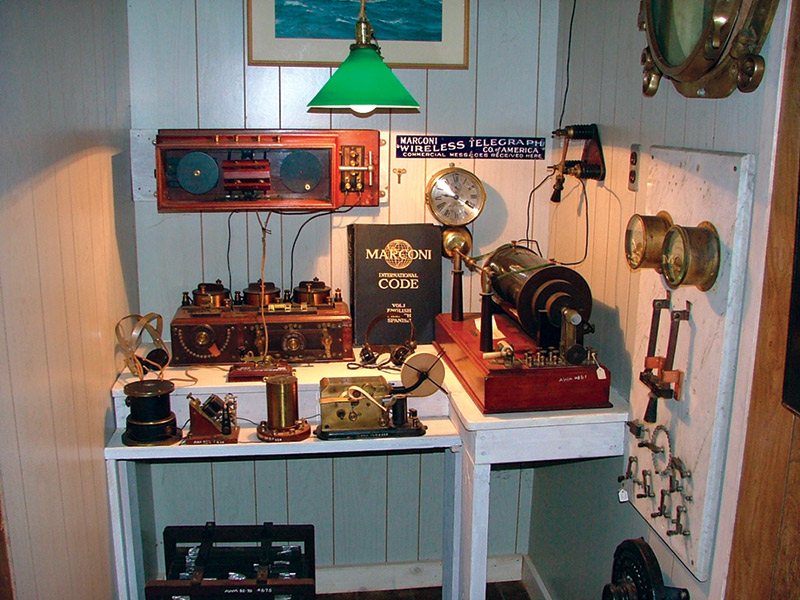
The AWA Museum has a model of the Titanic radio room because of the important role the 1912 Titanic disaster played in the development of wireless communications.
He said that although Marconi had developed wireless sets that were successfully used aboard ships, there were no laws or regulations governing the operation of the equipment. “So there’s the poor Titanic and it’s sinking and they’re sending SOS like mad,” said Gable. “Even though there were ships in the area that could have heard their signals, the operators had gone to bed. At that time, there was no requirement for them to be on the air and monitoring.” After that tragedy, regulations were developed to make sure distress signals were heard and, at the same time, new equipment was developed and became available.
Also on display at the museum is an early example of a police radio. The first radio sets installed in police cars were just receivers. “That was back in the days when you heard, ‘Calling all cars ... bank robbery at First and Elm’ and that was exactly it because all they did was transmit,” Gable said. “The cars could not talk back. If they had to call back to the station they would have to go to a telephone call box. The frequency range was just above the broadcast band. On a lot of the old radios of the 30s and 40s at the top of the broadcast band, you’ll see something labeled ‘police’ and that’s what it was.”
Because the major manufacturing center for early electronic communication was located in nearby Rochester, NY, the museum was able to acquire a great many of the examples of those first experiments in radio. For example, on display at the museum are the actual breadboards for the regenerative receiver, the superheterodyne receiver, and FM transmitter built by Howard Armstrong and his assistant.
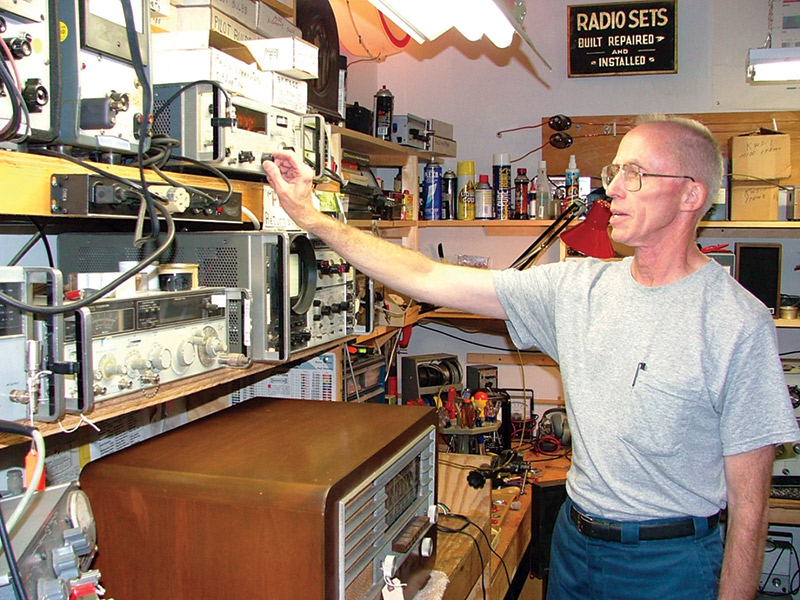
Jack Roubie, Facilities Manager for the Antique Wireless Museum in Bloomfield, NY works on restoring one of the many radios in the museum’s well-equipped shop.
Not all the experiments in radio were successful, of course, and some of those are also on display. One is the first attempt to design a high-fidelity AM broadcast transmitter. “It was a total failure,” Gable said. “They were desperately trying to improve the fidelity of the broadcast industry. The people who developed it had the idea to broaden the bandwidth to get it nice and wide to get lots of fidelity. Then they had to broaden the receivers, but all they did was make it more susceptible to more noise.”
Visitors to the AWA Museum can see an example of the very early days of television development with a working example of a television transmitter and receiver. “It’s a 1927 all mechanical TV system,” Gable said. “There are probably only a few of these anywhere that are working.” The mechanical television was the brainchild of prolific inventor Charles Jenkins. Gable said the amazing thing about the mechanical television is that while Jenkins was building his system in the United States, across the Atlantic a very similar system was being developed by John Logie Baird in England. “The two progressed almost identically with the same methods and procedures and they never knew the other existed,” Gable said. “It was incredible the way that happened.”
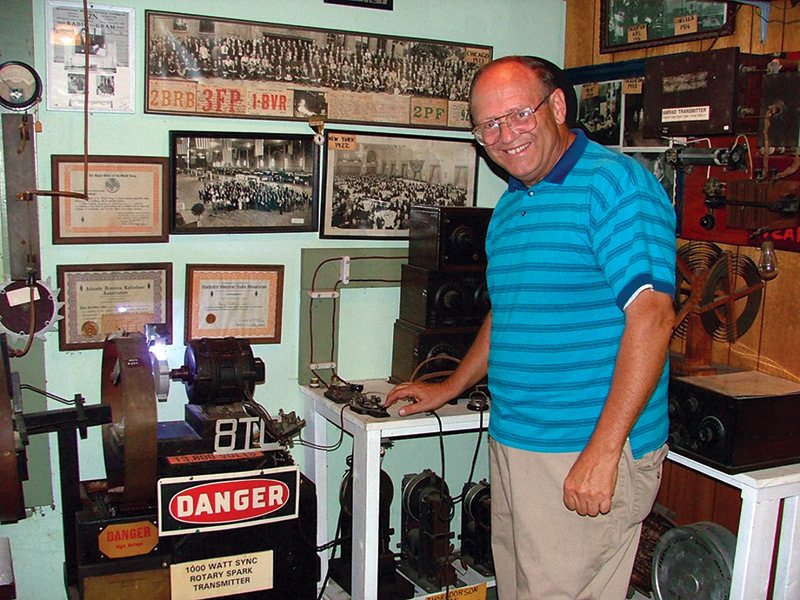
AWA Museum Curator Ed Gable operates the museum’s spark transmitter
Jenkins used his mechanical system to broadcast a program for about two hours every night. The entertainment value was limited and was intended mainly for hobbyists and experimenters. “It was on the shortwave band,” said Gable, “and he covered the entire Northeast from the Washington D.C. area. It was a fairly low frequency of about 3 MHz.”
Also on display in the television area are various models of early TV sets, including one used by David Sarnoff of RCA to test signals broadcast from New York. Sarnoff went on to become president of RCA in 1930 and in 1947 he was the CEO of the company. He was also instrumental in forming NBC — the first radio network.
Almost as soon as black and white television was perfected, work began on developing a color system. The AWA Museum chronicles the early battle among designers and networks to come up with a suitable color television system. On display is a mechanical color television system developed in 1946 that produced color pictures by having a spinning wheel with red, blue, and green filters in front of a cathode ray tube. “The transmitter would send red, blue, and green information and your eyes would average it out,” Gable said. “And it had beautiful color. It was actually far superior to the early RCA three-gun system.”
It was quickly realized that, although the system worked well with a 10-inch screen, eventually consumers would demand larger screens which would require a huge spinning disk. “For a 21-inch set, the wheel would have to be 13 feet in diameter spinning at 300 RPM in your living room,” said Gable with a laugh. This mechanical means of producing a color picture was used in 1949 to broadcast medical procedures from Pennsylvania and Atlantic City hospitals. In Atlantic City, viewers could come to the convention center to see broadcasts of operations. Reports from the time noted that the realism of seeing surgery in color caused more than a few viewers to faint.
The Antique Wireless Association Museum has large number of displays dedicated to the telephone. The museum has the first subscriber telephone dating back to 1877. “There were just two of these,” explained Gable, “and there was no operator. Just two telephones and a battery.” The direct connection with no ring capability had the obvious disadvantage that a time had to be arranged in advance to tell the other person when to expect a call. “It was very similar to the old tin can and string but worked a little better,” Gable said. “They were used mostly by industry and banks.”
One corner of the museum is dedicated to inventor and electrical engineer Edwin Howard Armstrong. Armstrong’s first contribution to radio was the regenerative circuit which he invented in 1912 and provided better amplification and fidelity. “It vastly improved radio reception capability,” said Gable. “His second contribution was the superhetrodyne receiver which is something we enjoy even today in radio. The third one goes along with the quest for high fidelity broadcasting or the elimination of static. And that was FM.”
Armstrong had an assistant — Harry Houck — with him for most of his career and, fortunately for those interested in the history of radio, sometimes Harry didn’t follow directions very well said Gable. After the development of each of the circuits that contributed so greatly to radio, Armstrong told his assistant to take it apart and throw it away. “Harry Houck didn’t do that,” Gable said. “He took the stuff and kept it in a box for 30 years.” It was then Houck, who was a member of the AWA decided to share those historic items with several museums including the Antique Wireless Association Museum. “So in little downtown Bloomfield, NY,” said Gable, “is the world’s first regenerative receiver, the major part of the world’s first superhetrodyne receiver, and the world’s first FM transmitter.”
Gable said Morse Code was originally developed to be detected by machine not human hearing. “You’ll see all over the museum examples of devices used to copy and print out Morse Code.” He said it was a Morse Code instructor in Syracuse, NY who first began copying code by hand. “He began listening to the sounder and got to where he could copy the code,” Gable said. “The machines were temperamental and were always breaking down and he got good at it and became a proponent and teacher of copying code.”
The AWA has a unique program for getting radios restored called, “Adopt a Radio.” Gable said the AWA has a convention every year and during that event people have an opportunity to participate in the program. “They can look at some radios we have set up in the annex and they can take it home for a year, work on it and restore it, and then bring it back the following year. It gives people a chance to work on radios they may never have an opportunity to work on. And, of course for us, it gets our radios restored. So it’s a win-win situation.” The restored radios are then put on display in the museum.
One area of the museum is dedicated to military communications with some rare items like a 1916 spark transmitter used by artillery spotters. Included in the display are a large number of items from World War II. One stands out from the rest. “It’s a Model 19 set,” explained Gable. “It has Russian characters on it. It was designed in England, built in America, and used by the Russians.”
Also on display is a huge collection of vacuum tubes including one of the very first vacuum tubes built in 1905 by John Ambrose Fleming.
One unusual tube on display was developed out of necessity, said Gable. “In those early days there had to be a way to pay for radio. In the US, we decided to sell advertisements, but in England and Canada, you bought a license. In Germany, you paid a tax on the number of tubes in a radio. And if you look at this tube, you’ll see condensers and resistors in there. They built the whole radio in a tube. So you only paid tax on one tube.”
The museum also tells the story of the transistor. The transistor was first developed by Bell Labs for use in the telephone industry. Bell Labs naturally wanted the radio industry to start using transistors instead of tubes. “They had a heck of a time trying to get a transistor to work all the way up to 100 kHz,” Gable said. They were finally successful and constructed a small portable transistor radio as a demonstrator. That radio is on display at the museum and the AWA has all of the original engineering documentation to go with it. “They took it on the lecture circuit to show anyone who wanted to listen. They sold the rights to several manufacturers including Regency who made the TR-1 (the first commercially produced transistor radio) in 1954.” That first transistor radio put together by Bell Telephone to demonstrate this new technology to potential investors is on display at the museum.
Many of the displays allow visitors to actually operate the equipment. They can talk to one another on 19th century phones and with the help of a guide can watch and hear spark transmitters in operation.
For more information about the Antique Wireless Association Museum, visit their website at www.antiquewireless.org. NV
Editor's Note - The museum moved to its new location in 2013 at 6925 Routes 5 and 20 Bloomfield, NY.

